

From interviews with the three surviving Space Fleet Solar Observation
Corps personnel present at first detection it is certain the Cryptosian
starship first appeared on the SOC astroscopes inside the boundary of the
Peril Perimeter at 2240hrs, July 11. No record was found of any radar or
astroscopic detection of the craft by the satellites of the Outer Observation
Belt, nor by any other Fleet monitoring facility in the inner or outer
system.
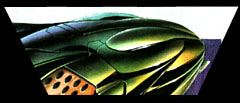
Fleet investigators at the time extrapolated the starship's probable
vector insystem and were satisfied that it had passed through two separate
and fully operational SOC detection monitors linked to the Outer Observation
Belt Network(1) with no trace recorded of its passage. This failure of
the OOB-Net could only be explained by the craft's possession of sophisticated
cloaking technology or that its velocity insystem was faster than light.
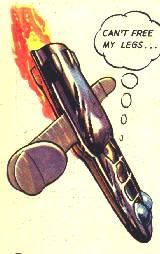
Ambassador Lero claimed to Fleet investigators that the starship had indeed vectored insystem at FTL velocities, and this claim was initially met with some scepticism by members of the Space Research Council who blamed mechanical failure of the OOB-Net satellite detectors. Ambassador Lero subsequently retracted his claim of FTL capacity for Crypt starships, but the Commission does not accept this retraction for anything other than an attempt at misinformation. Reasons for this conclusion are summarised in later sections of this report. The Commission is satisfied beyond any reasonable doubt than the Crypt starship arrived insystem and inside the Peril Perimeter(2) at FTL velocity. Their re-entry into normal space in such close proximity to their target planetary body demonstrates several points about their level of spacing technology.
1) It is conclusive proof, despite the later denial, of their possession of a non instantaneous non chrono-vectored FTL stellar propulsion system. This system is referred to by the Crypts as the Tengam Drive.
2) The Crypts possess an impressive deceleration capacity from FTL velocities. The Crypt starship 1 entered Nspace 955,000 M from Earth at a recorded velocity of 0.85 Lvel. This velocity rapidly dropped to 0.15 Lvel. in considerably less than one minute. Details of the Nspace breakout of Cry pt starship2, which outperformed in many ways the parameters of Crypt starship 1, can be found later in this report. This impressive deceleration capacity was only discovered by careful review of the magnotape records from the OOB-Net days later. Within 35 minutes it had decelerated to 3,0 00 mph and reached a distance of 8,000 M from Earth.
Interception by Space Fleet was achieved at 4,650 M at 94 minutes after
first detection and at 29 minutes after launch. This deceleration capacity
is well beyond our ability to emulate. The Galactic Pioneer and the Galactic
Galleon, which are man's only functioning starships to date, both require
deceleration to begin several Lyears before Nspace emergence, which is
effected at approximately 100 million miles from the target planet.
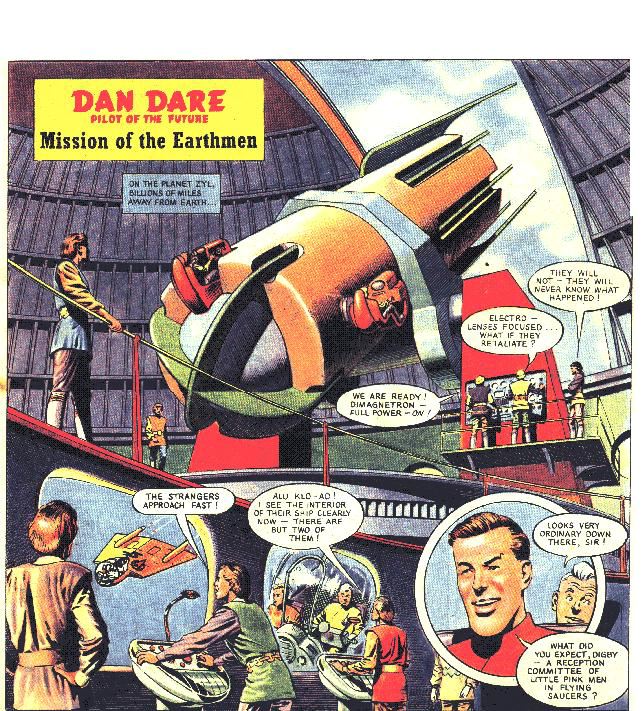
3) The navigation technology required to position Nspace breakout that
accurately in relation to the target planet on entering a new system is
especially impressive and totally beyond our current ability to emulate.
The Nspace breakout at second contact was even closer to Earth and crossed
the Mars Spacelanes only seconds later, coming within only 873 M of outbound
traffic. The Galactic Galleon, by contrast, emerged into Nspace 23 million
miles off target in both EpOp-inbound and outbound, for reasons that have
yet to be determined. It is possible that these problems are merely due
to our very limited experience with Halley Drive use.
Three Space Fleet Quick Reaction Interceptors, led by Colonel Dare,
launched from Maplin Spaceport within 65 minutes of penetration of the
Peril Perimeter and first detection. This slow response, which was 35 minutes
less than the simulated drill time for the QRIF, was caused by the absence
of the senior command officer, Controller-in-Chief Sir Hubert Guest, who
was attending a King's Birthday Reception at the Venusian Embassy in London
at the time of detection. The interception team nevertheless achieved intercept
29 minutes after launch and closed to weapons range 4,650 M from Earth,
matching course and velocity of 3,000 mph before issuing a challenge.
This challenge was ignored by the intruder and Colonel Dare was about
to order the squadron to fire upon the ship, as per Space Fleet Command
standing orders, when the ship sustained a spontaneous disabling explosion
in the midhull section and appeared to lose power. The apparently dormant
h ull was allowed to continue on its Earth intersect vector and impact
in the Tuscarora Deep in the Pacific Ocean. The cause of this explosion
was never satisfactorily explained by the Crypts, despite questioning by
Fleet investigators. No failure of wholly Crypt-designed and engineered
craft or hardware was ever subsequently observed by the Cryptos Expeditionary
Team (CET).
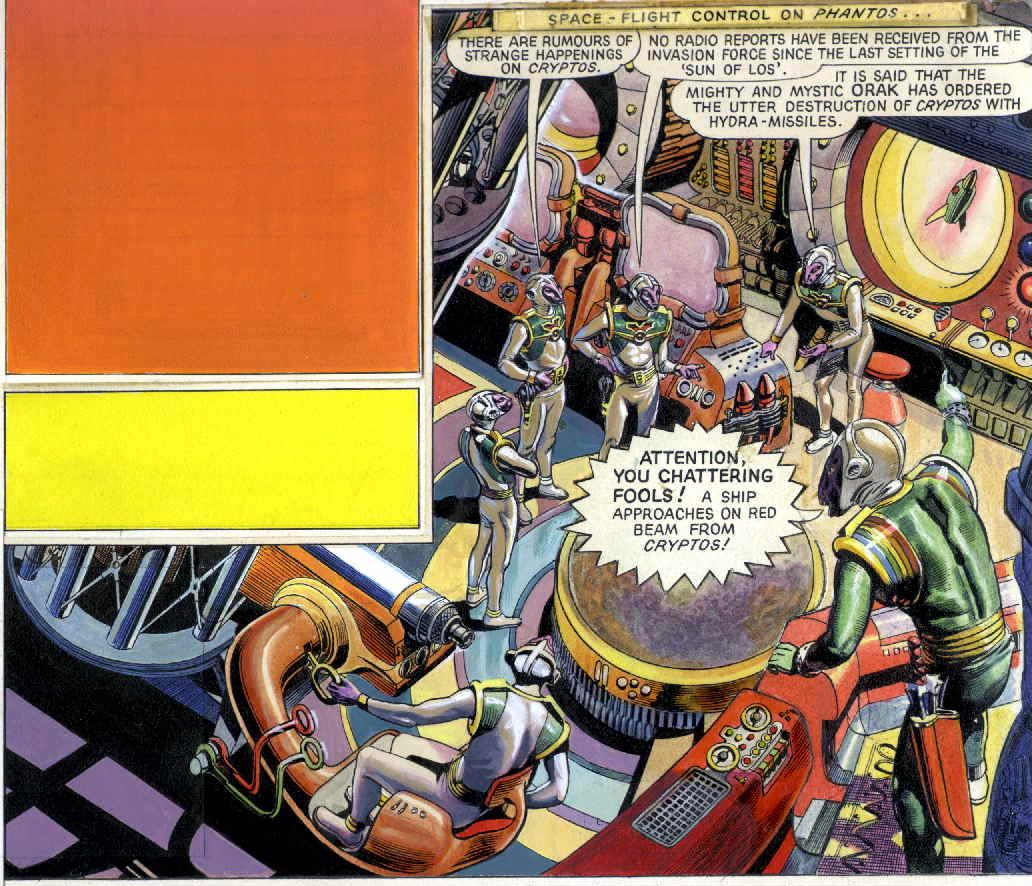
It is considered highly probable that the explosion and subsequent crash was deliberately staged by the arriving Crypts to gain sympathy from the World Government and the population at large. Their success at achieving this goal demonstrates a sophisticated understanding of human psychology. By presenting themselves as helpless, stranded travellers they greatly increased the likelihood of help from humanity. Preparations were immediately begun to salvage pieces of the wreck from the Tuscarora Deep by the multipurpose deepsea exploratory vessel HMS Poseidon. The starship was, however, found virtually intact on the seabed under 6 miles of seawater, having survived an ocean impact calculated to be in the vicinity of 8 megatons.
No eyewitness survived the hull's oceanfall, but weather satellite records examined later showed no major energy release in the impact zone. The willingness of the Krux Tricell to remain shipboard when means of escape was easily at hand in the form of Spacial T orpedoes, and their subsequent survival of the high velocity Earth impact, make it highly likely their ship was under occult deceleration and guidance. For the Crypt hull to have survived the explosion and a high velocity atmospheric re-entry, coupled with even a moderately controlled oceanfall, followed then by the pressure of 6 miles of seawater, demonstrates hull engineering expertise in strength and impact resistance totally beyond our ability to emulate.
Salvage was fortunately rapidly effected by the new Limpet Grapple System
(LGS) which was being tested for deep sea rescue at the time by the Royal
Navy. Once the craft was raised a Treen Mekontan Superlifter Veteo-Crane,
on trial with the RAF at the time, carried the ship halfway around the
world to Formby Spaceport in the biggest lifting and midair refuelling
o peration of its kind ever attempted.The Japanese government's attempt
to claim possession of the wreck before the UNWG Assembly failed and they
were forced to accept a fait accompli, as the Superlifter was already over
India by the time its representative rose to speak before the Assembly.
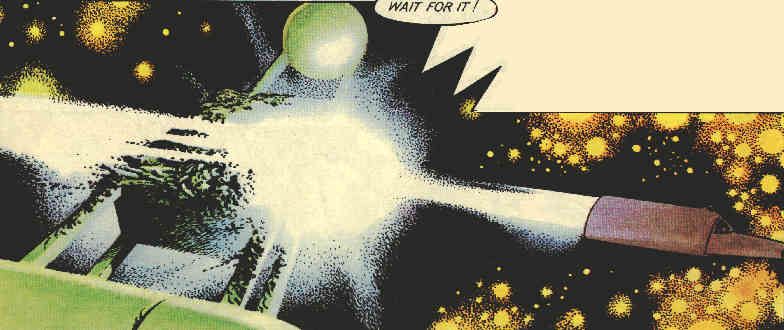
Unfortunately the Engineering Section was able to acquire only a small
section of damaged hullplate (19in x 13in x 5in), which they were then
and still are unable to section by non destructive means. The hull material
is composed of a complex interlacing three-dimensional hexagonal crystalli
ne structure that is stronger by many multiples than any hull plating in
use anywhere in the Solar Federation.(6)It is resistant to heat equivalent
to that of high velocity atmospheric re-entry and to short exposure to
disintegron rays. Energy imparted to any portion of the hullplate, whether
from a projectile or beam weapon, is instantaneously transferred equally
to all the component molecules of the hullplate.
This is certain to be true of the Crypt hull itself, which would act as a considerable potential energy sink. Space Fleet Weapon Analysis estimated at the time that it would take a direct hit with a Multum Mark V nuclear tipped missile to effectively destroy such a ship. This analysis was proved correct when the Crypt starship was attacked Cryptos inbound by Phant Raiders and sustained repeated multiple non nuclear warhead missile impacts before the CET were forced to abandon ship. Despite further repeated multiple warhead strikes on the crippled ship the hull survived in sections and was salvaged by a Phant Spacecarrier. The hull's subsequent arrival on Phantos was witnessed by Cadet Spry, who found the interior well preserved.
This hull composition appears quite different from that of the 1994
''Venusian'' spaceship wreck, which was constructed of interlacing circumferential
fibres composed of living plant cells.
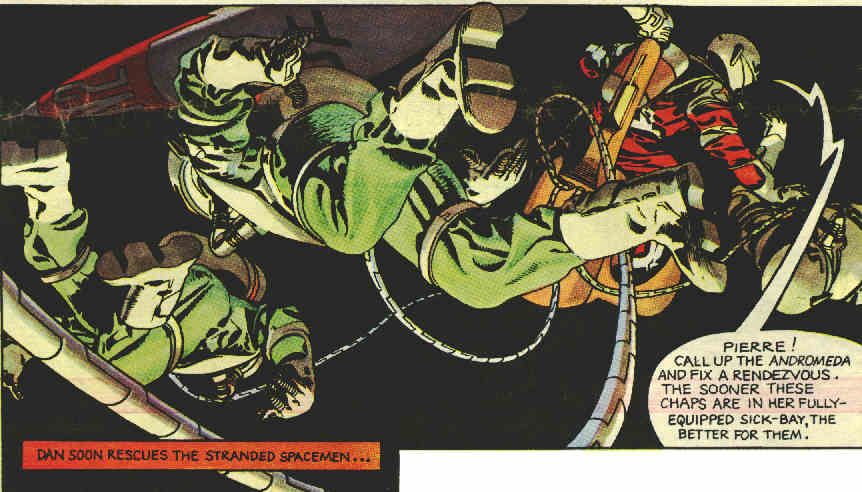
Space Fleet Engineers involved in the repair of the Crypt starship
observed no seams or rivets in the entire ship. They speculated at the
time that the exterior and interior hull were all part of a single moulded
structure formed or grown originally in one piece, as we also speculate
was the "Venusian" spaceship wreck. Repair of the Crypt hull would have
been impossible by the Formby Space Fleet Shipyards without the aid of
the Crypt Tricell. Repair teams soon found the hullplate unworkable by
conventional engineering methods, until aided by the engineer component
2 of the Krux Tricell. The Krux was able to induce changes in the hull's
rigidity in order to aid repair of the damaged sections. This was effected
from the ship's internal controls and was presumably an electromagnetic
or magnetic energy passed through the localised hull area. This energy
altered the crystalline structure to the point that the damaged hull could
be moulded by the repair teams with a consistency they described as that
of soft plastic.
The three wing mounted engines survived Earthfall attached to the hull, and intact, and no excuse could be found to dismantle them, if indeed we would have been able to. The Crypt Tricell insisted, despite considerable scepticism from Fleet engineers, that the impact and the subsequent immer sion in seawater under very considerable pressure would not have harmed their drives. Fleet examiners found the engine exhausts sealed by a flexible translucent membrane, which the Krux assured them was normal and was automatically generated to protect the engines in emergency mode. These engines were apparently used for intrasystem manoeuvring and are probably the Crypt's equivalent of our recently developed photon drive. No information as to their operating principle was given by Ambassador Lero, despite direct requests by the examination team.
The Tengam Drive proved even more elusive to Fleet investigators. Ambassador Lero avoided all discussion on Tengam Drive design or theory and refused to disclose its location onship. Investigators examined the mechanism that later proved to be the Tengam Drive housing and dismissed it as unimportant. The drive appeared to have no conventional exhaust, and either functioned without one or through interaction with the three wing motors. A summary of the other known characteristics of the Tengam Drive can be found later in this report.
Extensive examination by Space Fleet propulsion scientists during the
refitting of the Crypt Starship resulted in the unanimous agreement that
Crypt physics was based on entirely different principles to the Hemming
Unified Theory. This was especially frustrating to Space Fleet scientists
at the time, given their previous inability to understand the principles
behind the propulsion system of the so called ''Venusian'' spaceship wreck
that they had been studying unsuccessfully for six years until its loss.
This frustration was contributed to in no small way by the forced realisation
that they had had a starship in the Maplin Spaceport for six years and
had refused to believe it.
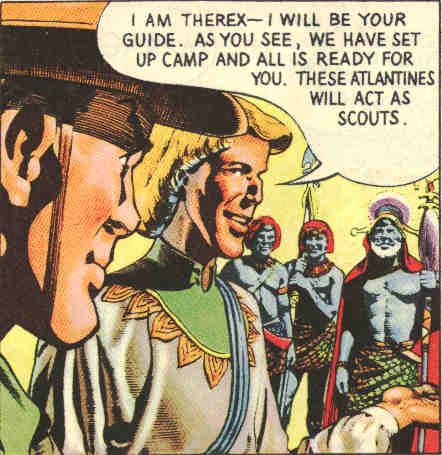
The recent Halley Modification of Hemming Theory, while allowing for
FTL travel, does not bring us any closer to an understanding of Crypt physics.
It does however give us the potential capacity to search for Los system
ourselves under our own terms, although it is unlikely we will ever be
able to do so for reasons that will examined later in the report.
The hull plating acquired during repair of the Crypt Starship and most of the visiotape records made of the interior were recovered intact from Mekonta after the Bipartite Occupation. The Mekon had assigned a team of level one scientists to research and duplicate the Crypt hull plating. The project began in 2003 and was a partial success although it did not succeed in its ultimate intention of duplicating the hullplate structure. The Treen scientists did however succeed in altering their own armour plate along the same principles, though with less efficiency, and this was applied to the Mekon's second generation robot combat troopers, the Selektrobots, to proof their casing against light antipersonnel beam weapons.
All Treens involved in this research have been interned and quarantined offworld in the UNWG Martian Detention Camps.
| Richard Grosser
CADRE Systems Architect |
Ph: +643 3890564
Fax:+643 3890569 |
| PO Box 22-095
Christchurch New Zealand |
grosserr@v1.chchp.ac.nz
http://www.chchpoly.ac.nz |
| cadre@ext.canterbury.ac.nz
http://www.geocities.com/ResearchTriangle/Lab/1286 |
|
| https://members.tripod.com/~rgrosser |
|
|

|